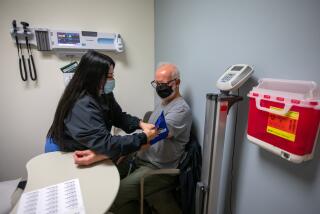Ethics of Dying a Dilemma for Doctors, Patients : American Way of Death Encumbered by Technology Designed to Prolong Life
WASHINGTON â For too many people near the end of life, the American way of death has become a slow, painful one.
It has become encumbered by respirators and feeding lines, tubes stuffed into noses and throats and, sometimes, hands tied down to prevent a suffering patientâs desperate removal of such devices.
âUnfortunately, the quality of the additional life so skillfully sought can range from marginally tolerable to positively miserable.â So stated a Stanford University group in The New England Journal of Medicine two months ago--in the same week that the Journal of the American Medical Assn. printed the shocking story of a doctor cavalierly ending the life of one suffering patient.
Staple of Television
The sight of a cluster of doctors and nurses reviving a patient whose heart has stopped or begun a last, fatal fluttering has become a TV doctor show staple. But of all the cardiopulmonary (heart and lung) resuscitations at one major medical center in a one-year period, only 14% survived to leave the hospital.
Patients, concerned physicians say, should be consulted by their doctors about their wishes in case extreme measures are needed. Studies show that only one affected patient in five has ever had such a discussion.
As for our doctors, they are imbued with an ethic that says: Save life, maintain life. Who would destroy this? Yet there must sometimes be compromise. Addressing medical students in the year 1858, Dr. Jacob Bigelow, a prominent American physician, said they must assure their patients âsafe passageâ into death.
âYou Can Cut the Tensionâ
The traditional medical ethic, the new machines that sometimes do too much, the threat of legal action if they do too little--all place todayâs doctors far beyond the ken of that 1858 speaker. âSometimes you can cut the tension in these hospital rooms, itâs so thick,â said Dr. Ronald Cranford, Minneapolis neurologist.
What reasonable guidelines can patients and doctors turn to? Several groups--often including physicians, nurses, ethicists, clergy, lawyers, other citizens--have been considering this. They include a 1983 Presidentâs commission, a 1987 panel assembled by Congressâ Office of Technology Assessment, a 1987 panel assembled by the Hastings (bioethics) Center, the Stanford group and others.
Their main recommendations are summarized below.
Panels of physicians, patients and authorities on the law and human values have agreed on guidelines like these to help patients and care givers cope with an era when most of us want to live long, rewarding lives but not suffer long, meaningless dyings.
The wordings here are sometimes borrowed from the originals, sometimes paraphrased.
- Patients have a right to make their own decisions about treatments or other interventions to sustain life. They may say ânoâ to any, including artificial nourishment or resuscitation.
- Doctors and other health professionals are obligated to sustain life--unless doing otherwise is the considered, informed choice of a mentally competent patient. The authority over a patient does not reside in the physician but in the patient.
- Doctors and others are obligated to take enough time to discuss these matters with patients and tell them of choices, even to tell them they have a right to accept death. Only in emergencies may physicians act without consultation, although the possibility of certain emergencies should have been part of an adequate discussion.
- Patients should rarely, if ever, be denied the truth. The anxiety of the unknown can be far more upsetting.
- Health professionals should make sure a patient is not rejecting life-saving treatment only to get relief from suffering that could be relieved with adequate medication. Physicians who are unsure about adequate doses of morphine or other drugs should consult a specialist in relieving pain. A physician need not fear giving an adequate pain-killing dose to alleviate suffering in a dying patient, even if that dose might hasten death. To quote the Ethical and Religious Directives for Catholic Health Facilities: âIt is not euthanasia to give a dying personâ necessary sedatives, âeven though it may deprive the patient of the use of reason, or shorten his life.â
- Hospitals and other health-care institutions should have formal, well-understood policies to protect patients from needless suffering and physicians from legal action. In 1986, the Joint Commission for the Accreditation of Hospitals found that only 59% of such facilities had either formal or informal resuscitation or no-resuscitation policies. The commission now requires such policies.
- Patients should make their wishes known to their doctors and families--preferably before they ever become patients. They should name an agent or representative--a spouse, family member or friend--to speak for them if they are unable to do so. A binding way to do this is to confer a durable power of attorney, which may be limited to medical matters.
- Such a surrogate should follow the patientâs wishes. If that is not possible, the surrogate may apply what is known about the patientâs values, trying to do as the patient would have done. Or, if even that is not possible, the surrogate should try to choose as a reasonable person would.
- When no surrogate has been designated and a doctor faces a patient who cannot speak competently, the doctor is obligated to consult with the patientâs spouse, family and perhaps other appropriate persons--clergy, friends--to try to determine what the patientâs wishes might have been. In difficult situations--as when family members disagree--a doctor may consult members of a hospitalâs ethics committee for guidance. In some situations, a doctor or hospital may have to ask a court to name a guardian.
- A health professional may disagree with a familyâs decision on a course of action--or inaction--or decline to execute a patientâs wish if it violates conscience or religious belief. But a physician must then help the patient or family to find another physician in an orderly manner, without prematurely abandoning the patient.
Hospitals should make sure all patients get copies of their rights.
These are among the rights put forth in the American Hospital Assn.âs document:
- The right to considerate and respectful care.
- The right to receive all the information about an illness, treatment plans and alternatives to give truly informed consent.
- The right to participate actively in decisions on care.
The following is reprinted from âLife-Sustaining Technologies and the Elderly,â a 1987 report by the congressional Office of Technology Assessment:
A newspaper article described an 82-year-old woman who was put on a mechanical ventilator (respirator) following bypass surgery.
She could not talk because of the tubes in her throat but wrote notes to her daughter, saying, âPlease let me die.â The tubes were not removed, and when she tried to pull them out herself, her hands were strapped to the bed.






